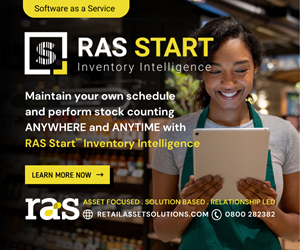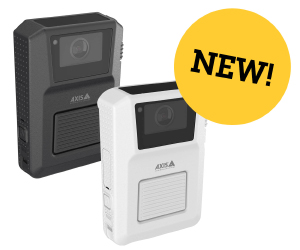INDUSTRY FOCUS
Improving inventory record accuracy
Why it matters for the business and why it should be on the LP agenda
by Colin Peacock, ECR Retail Loss Group
Most, if not all, of us have heard leaders use the rallying cry, “If not now, then when? And if not us, then who?” I suggest, given the sales increase opportunity offered by improving inventory record accuracy (IRA), that now is the time and the “us” should be you, the loss prevention team.
A Wake-Up Call
Picture the scene: an ECR Retail Loss Group retail loss meeting held in May 2016 in the Prague offices of Unilever with over sixty retail executives present. It is time for a benchmarking presentation on physical inventory counts conducted in forty stores of a multiple-grocery retailer.
By way of background, all retailers are required to conduct regular physical counts, to ensure that their financial records match what is physically in the stores and to record any discrepancies (often referred to as shrinkage). The data from these counts is then used by finance and audit teams to ensure they are compliant with accounting standards, while for store managers and LP, it provides one of their key performance metrics. These audits can also provide a measure of the level of accuracy between expected and actual stock records. If a store has 10,000 stock keeping units (SKU) and of those 8,000 have an exact match, then the IRA rate would be declared as 80 percent.
From this perspective, the focus would be on the 2,000 SKUs without an exact match. They could be higher or lower, but both represent a failure in process and can lead to negative consequences for sales and managing costs.
This view of the physical count data was presented at the ECR Retail Loss Group meeting in 2016. The data showed that 53 per cent of the 800,000 records were exact matches. For the remaining 47 per cent, some 59 per cent had a physical quantity less than expected, and 41 per cent had more than the book record suggested. When I first saw this benchmark data, and knowing how many millions of euros are spent by retailers on ever increasingly sophisticated forecasting and replenishment systems that are reliant on accurate data, I was shocked. But more to the point, how did the retailers present in Prague react?
Firstly, many just nodded and said that this was broadly in line with what they saw in their businesses. Secondly, some shared that they measured IRA in a different way, and rather than the exact match definition, their organisations declared an inventory record accurate if it was within a predefined zone or tolerance level, for example, +/- 5 per cent or 2 units. Using this definition of accuracy, their IRA rate was significantly higher, sometimes greater than 90 per cent. Finally, some in the audience simply did not know how this compared as they had never seen this measure used in their businesses. Instead they only looked at and focused on the value of inventory variance, typically a negative value or loss, by store and department, but rarely at item level.
I then asked for a show of hands as to which retail organisations currently had an active project in place to improve IRA. No hands went up, other than from an apparel retailer who had just started an RFID project, where improving IRA was one of the major value drivers. I then asked why virtually no retailer present was working on what seemed, to me at least, to be a big problem. Here are some of the explanations:
Precision not needed—many stated that inventory records did not have to be exactly right. If the inventory record is stating that (for example) ninety items are in the system and the audit count finds eighty-nine or ninety-one, what would be the benefit of allocating and investing resources to make sure it always shows ninety? For many, it would seem to be a waste of time.
No one talking about it—the issue of IRA was not discussed with the board, in company meetings, at regular strategy reviews, or even store visits. They shared that no function—sales, supply chain, or stores—had IRA as a key performance indicator (KPI).
No sense of urgency—respondents regarded the data as not new. Company records have been wrong consistently for ages, so why would they want to act now on an initiative that would inevitably consume a lot of resources and require investments in technologies, training, and people? What would be the call to action?
Call to Action
Further discussion focused upon two areas that could drive a call to action. The first was on the shopper. For most, if not all, bricks-and-mortar retailers, an increasing number of shoppers are either taking all their shopping online or checking prices and availability on a company’s website prior to visiting a physical store. To avoid disappointing this type of shopper, retailers need to have full confidence in the accuracy of their inventory systems. For reasons that should now be clear, however, many retailers simply do not have this level of confidence and “solve” the problem by adding extra inventory into the system and declaring items unavailable whenever there is a presumed quantity below an agreed number. This is sometimes referred to as “safety stock,” and while it helps resolve this problem, it requires additional investment in inventory and, inevitably, can lead to lost sales when stock that is available is listed as not.
The second area that was considered capable of driving a call to action was the emergence of new data that could help support a business case for investing in IRA. The key question was whether improving IRA would lead to an increase in sales. At the time of the ECR Retail Loss Group 2016 meeting, no academic papers were available that could answer this question. Given this, the ECR Retail Loss Group decided to commission research to try and shed some new light on this issue.
Building the Business Case for Improving IRA
Three academics from the University of Cardiff (UK), the Emlyon Business School (France), and the Technical University of Darmstadt (Germany) were appointed. Between them, they had a deep knowledge of the problem of IRA, online and offline retailing, the manufacturing sector (automotive parts), and experience using technologies such as RFID to improve IRA.
They were tasked with designing and delivering a field-based experiment to prove (or not) that sales increased when IRA was improved. To support this aim, they designed an experiment consisting of matching test and control stores where initial stock counts would be completed, after which all book stock inventory records would be corrected to what was physically found in the audits. After twelve weeks, there would be another stock count in only the test stores, and the inventory records would again be corrected. At the end of the next twelve-week period, both the test and control stores would again be audited, and the rate of sales in the test stores compared with those in the control stores. Seven large European retail chains from the food and clothing sector agreed to provide data, and in total, the study collated twenty-four weeks of data from over 1 million SKU records in over ninety retail stores.
The first set of data revealed that 60 per cent of inventory records counted were inaccurate—an IRA rate of 40 per cent. Of those SKUs that were inaccurate, 53 per cent had physically less stock than expected according to book stock records, possibly due to factors such as theft, scanning errors (especially at self-checkouts), and unrecorded write-offs. For the remaining 47 per cent of SKUs, more stock was found than expected, possibly due to scanning errors, undercounting from previous audits, and/or over-shipment from distribution centres (DCs).
More importantly, the academics were able to prove that when the inventory records in the test stores were corrected midway through the experiment, they found a sales increase of between 4 per cent and 8 per cent. For those SKUs where the inventory records showed a negative variance, sales increased 10 per cent. Perhaps not surprisingly, for the 40 per cent of items with an exact match, there was no sales increase. However, for those SKUs with a positive variance, there was a sales increase of 8 per cent. In many respects, this seems like a confounding finding. Why would having more inventory than you thought and correcting it result in a sales increase?
In discussions with the participating retailers, the academics learnt that SKUs found to have a surplus compared with expected book stock records often had stock located in various locations away from the shelf, which was invariably empty. In this respect, these SKUs were suffering from a phantom out of stock—it was within the store but located in a place where it was not available for sale. The audit process identified this stock and reset the system and associated shelf replenishment, kickstarting the selling process. Hence, awareness of positive variance led to an increase in sales.
With the business case for IRA improvement showing a 4 to 8 per cent sales increase, and with insights on other potential benefits of improving IRA such as reduced inventory holding and productivity, the findings were published and presented to the industry in February 2019. Since publication, the results have been reproduced in multiple supply chain articles and presented at numerous conferences, and the report has been downloaded hundreds of times from the ECR Retail Loss Group website, mainly by those in supply chain and audit roles.
Inventory Record Accuracy: A Loss Prevention Responsibility?
You may be wondering what this has to do with loss prevention. Well, to answer this question, it is instructive to look at some important research that focused on understanding how loss prevention could better engage with other parts of a retail organisation, especially the buying function.
Led by Nicole De Horatius and based upon interviews with thirty-one USA retailers and over 300 buyers, the research found the following. First, loss prevention teams were noted as infrequent visitors to the buyer’s office, with only 25 per cent of buyers recalling a meeting with them in the last twelve months. When they did meet, buyers viewed the data presented by loss prevention as simplistic, often just a list of the top loss items for their category as a per cent of sales, with no root-cause analysis. Further, the proposed interventions all seemed intent on tackling one root cause—theft—often with a very negative impact on sales and shopper satisfaction. As such, the loss prevention team were often seen as adversaries, fighting against the buyer’s goal to grow sales, and so were best avoided.
One of her principal recommendations was that LP should adopt IRA as a measure. In her view, this would help move the perception of the problem from being viewed as only about theft to a problem that transcends the organisation, especially when the data showed that there were as many positive variances as there were negative ones.
By adopting IRA, the LP function can begin to make better and more influential links with buyers, supply chain leaders, and others, showing the value they can bring to improving on-shelf availability and promoting sales. This in turn can make broad-ranging dialogue about other issues relevant to LP more likely with these functions as they have built credibility and perceived value, which in turn may encourage the greater reciprocal support and assistance.
Returning to the question: what does IRA have to do with LP? The answer in short is that by adopting the IRA metric, a more intuitive and compelling metric than just unknown loss most commonly associated with shop theft, more parts of a retail organisation are likely to be engaged to address the retail loss problem. If this context is familiar to you, then here are five valuable contributions you can make to help lead the company’s response to the business opportunity of improved inventory records.
Inventory Record Accuracy: A Five-Step Action Plan for the Loss Prevention Team
Step 1: Display the metric in your scorecard. Include IRA, as defined in this research, as another core metric for your team and display it on your scorecard. Also consider adding an improvement target. For example, declare that in this financial year, your team will increase the percentage of stores where IRA is improving versus last year, from (say) 35 per cent to 45 per cent.
This step may be more obvious and access to the data easier if your team is already conducting the counts or owns the relationship with the third-party audit provider. However, if your team are not the owners, plan a meeting with that team, share your intentions to track this metric, and request access to the data. A clear advantage of this approach is that when the IRA data is displayed alongside the shrink data, the relationship between the two can become clearer for all those managing inventory loss and variance.
Step 2: Dive deeply into the data. Invest time as a team or a dedicated resource to deeply interrogate all your existing inventory count data through the lens of IRA. Here could be two basic lines of enquiry: What are the items with the most positive gains? Are there similar looking items on the negative variance? Do these items also appear as positive gains on the audits of other stores?
For the items with the highest negative variances, to what extent would your judgement suggest that the primary reason they are showing such a negative variance is malicious versus non-malicious causes? For non-malicious items, does the data show that these losses are location-specific or a problem experienced across all stores, suggesting the items were set up incorrectly by the buyer?
One retailer, who has been undertaking this type of deep investigation work on store count data for over fifteen years, annually discovers causes of losses and gains that when resolved reduce their unknown loss number by circa 15 per cent. By removing these systemic issues—such as DC shorts or over shipments, errors in pre-filled display quantities, promotional offers set up incorrectly, incorrect recipe quantities for production items, vendors under or over shipping, and system issues such as crashes that eliminate or duplicate data—organisations can secure greater accountability in stores and help to remove excuses.
Step 3: Talk IRA. As an LP team, take time to regularly talk IRA (and the causes of inaccuracy) with all parts of the business. In the first instance, ensure that other parts of the business, especially the buyers, understand that the IRA metric and the more familiar unknown loss (shrink) number are two different metrics originating from the same audit data.
Secondly, focus the discussion on item-level analysis, perhaps creating a company top 100 gains and losses list, displaying the highest item-level variances, both positive and negative. This view might be refreshing to others and a contrast to what is normally shared by the LP team, which is a view (often at category level) of the value of negative variances found in the audits. It will also help debunk the myth that unknown loss (shrink) is simply just a theft problem best solved by those in security roles.
Finally, invite questions and debate on possible explanations for the variances. For example, why is there variance between stores? Why do stores served from different DCs have different rates of IRA? Why are some categories and items within categories more accurate than others? These conversations will naturally invite further analysis. For example, is there a correlation between IRA and rates of store shrinkage?
Step 4: Analyse the size of the prize. Plan to create a case for a “step change” in managing the inventory record inaccuracy (IRI) problem in your organisation by repeating the ECR Retail Loss Group research experiment to confirm your size of the prize and the potential sales gains from greater inventory accuracy.
To assist your team, seek help from others, for example, the market research team to design the experiment and a business data analyst to analyse the data. Alternatively, consider external resources such as your third-party count vendors or academia. By working collaboratively with other parts of the business and/or with experts outside of the company, you will not only ensure that you have the right expertise, but also have greater credibility when presenting the results, which will help to secure the necessary support you need to get started.
Step 5: Start a fire. Under the leadership of LP and with the endorsement of the board and C suite, establish a cross-functional team to align on the drivers of IRI, and start to set up efforts to drive the relevant improvement opportunities:
Company-wide awareness programme—increase awareness of the metric, its relevance and financial significance, and the role each leader plays in improving IRA.
Incentive and bonus design—introduce IRA as a measure for all functions and/or as a discrete element in the incentive plan.
Master file management accuracy—undertake audits of the master file by buyer and by vendor; seek to understand their respective compliance rates and encourage progress and improvement.
Logistics and distribution centre pick accuracy—adopt new incentives, procedures, and technologies to improve accuracy rates and reduce the quantity of mis-picks and wrong quantity shipments to stores that deteriorate the IRA of stores.
Inventory count frequency—consider the business case for increasing the frequency of inventory counts for stores and for certain categories to restore accuracy and to recover lost sales.
RFID—consider or reconsider a project to investigate whether there can be a business case for the use of a mobile reader and the application of RFID tags on cases or items to improve IRA (where this technology is suitable).
The cross-functional team should meet regularly, and findings and actions reported up to sponsors on a quarterly basis, together with recommendations on the business case for investing in new initiatives such as data analysis or technology.
Your Turn
This article set out to make the case that improving IRA should be a business priority, and with the research confirming a 6 per cent growth in sales, the time to act is now. The article then made the case that if the loss prevention team adopted IRA as a metric, it would help them increase the engagement of others in managing unknown loss, especially the buyer function. Finally, we have presented five valuable contributions that could help position the loss prevention team at the forefront of managing the problem and the opportunity.
It is, of course, impossible for ECR Retail Loss Group to know whether any of these recommendations are relevant or not to your organisation and your team, but we think they can be. We also believe that IRA will grow in relevance for all retail businesses as their operations become more complex, with inventory in many more locations and with greater volumes now heading backwards as rates of returns increase.
As with all previous articles, we would welcome your feedback and any examples of how you have been able to use this article to generate internal debate, discussion, and possible new actions. This research, and other research on retail loss management, is freely available to download from the ECR Retail Loss Group website. In addition, there is no cost to participating in future ECR Retail Loss Group meetings or research studies. To learn more about ECR Retail Loss Group, visit the website at ecr-shrink-group.com or email info@ecr-shrink-group.com.
COLIN PEACOCK is a visiting fellow at the University of Leicester and the strategic coordinator for the ECR Retail Loss Group. Prior to these appointments, he had a thirty-year career at Gillette and Procter & Gamble. Peacock can be reached at colinmpeacock@ecr-shrink-group.com.






